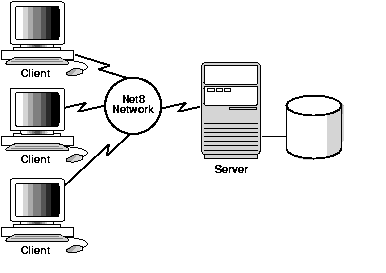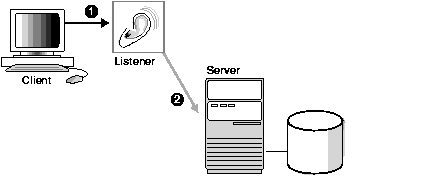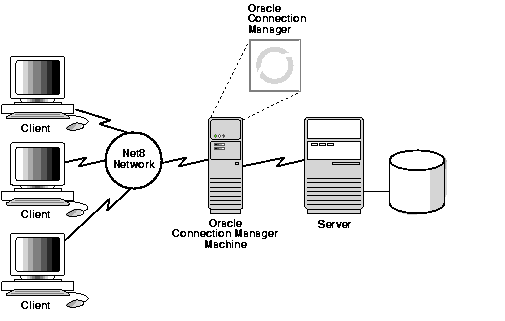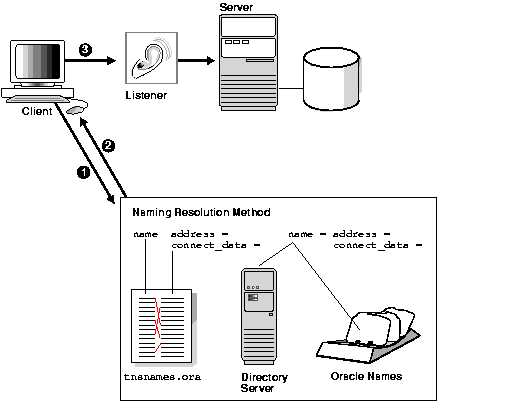Release 8.1.6
Part Number A76933-01
Library |
Product |
Contents |
Index |
| Net8 Administrator's Guide Release 8.1.6 Part Number A76933-01 |
|
This chapter introduces Net8 and provides an overview of its main applications, features, and functionality. It includes the following sections:
Net8 enables services and their applications to reside on different computers and communicate as peer applications. The main function of Net8 is to establish network sessions and transfer data between a client machine and a server or between two servers. Net8 is located on each machine in the network. Once a network session is established, Net8 acts as a data courier for the client and the server.
Figure 1-1 shows a client-to-server connection.

Network sessions are established with the help of a listener. The listener is a separate process that resides on the server. The listener receives incoming client connection requests and hands these requests to the server.
The listener brokers the client request, handing off the request to the server. Every time a client or server acting as a client requests a network session with a server, a listener receives the actual request.
Figure 1-2 shows a listener in a connection request.

For environments in which a large number of connections must access the same service, Net8 offers a connection routing process called Oracle Connection Manager that usually resides on a machine separate from the client or server.
Net8 offers connection routing for environments where:
Typical Net8 connections require the client and server to have the same protocol installed.
Figure 1-3 shows how client connections are routed to Oracle Connection Manager, which resides on a separate machine in the network.

Net8 allows connections to various services, such as Oracle databases and non-Oracle databases. Because an Oracle database is the most common service in an Oracle environment, this section focuses on database services.
When a user connects to a database service from across the network, a connect descriptor containing network information about the destination service is passed to the listener.
A connect descriptor contains the:
Connecting with a complete connect descriptor creates a lengthy connect string, as shown in a connection to a database service named sales.us.acme.com in the following example:
CONNECT scott/tiger@(description=(address=(protocol=tcp)(host=sales-server)(port=1521)) (connect_data=(service_name=sales.us.acme.com)))
To avoid a lengthy connect string, a connect descriptor can be mapped to a connect identifier. A connect identifier can be a net service name or the actual name of the service. This information is then stored in at least one naming method. Clients need only to use the connect identifier in the connect string. For example, if a net service name called sales is mapped to the connect descriptor used in the example above, clients can use the following connect string:
CONNECT scott/tiger@sales
During a connection request, the client contacts a naming method to resolve sales to a connect descriptor. The client then forwards the request to the listener address specified in the connect descriptor.
The listener, through a protocol, accepts the client connection. It compares the client information with the information it has received from the database, as well as information it has stored in its own configuration file, listener.ora. If the information matches, a connection is granted.
Configuring the network for connections consists of two main tasks described in the following sections:
A naming method must be configured to map connect identifiers to connect descriptors.
Net8 supports several categories of naming methods, including:
Net service names can be stored in a local configuration file called tnsnames.ora on each client in the network. Because the tnsnames.ora file can be configured on individual clients, it allows you to fine tune for a particular client's needs.
Service addresses and net service names can be stored in a Lightweight Directory Access Protocol (LDAP)-compliant directory server.
Service addresses and net service names can be stored in a system of Oracle Names server. Oracle Names is an Oracle-specific name service that maintains a central store of service addresses.
Service names can be stored using an existing IP address translation mechanism.
If a third-party naming service is already configured in your environment, Net8 supports storing service address information in it to avoid additional configuration.
Once a naming method is configured, clients must be enabled to access the naming method.
Figure 1-4 shows a client resolving a connect identifier through a tnsnames.ora file, directory server, and Oracle Names server:

A listener is configured with one or more listening protocol addresses and information about the destination service.
Protocol addresses are configured in the listener configuration file, listener.ora. Service information may or may not be configured in the listener.ora file:
listener.ora file.
listener.ora file.
|
|
 Copyright © 1996-2000, Oracle Corporation. All Rights Reserved. |
|